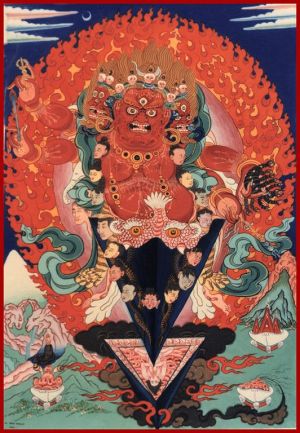The Instruments Used in Chod
Ritual music in Tibetan Buddhism is distinguished from secular music by the association of specific symbolic meaning with the musical sounds and the instruments used to produce them. That being said, there are a large number of possible meanings for every symbol, and these meanings differ depending upon one's viewpoint and specific tradition. This should be kept in mind when examining the various instruments involved in Chod. Unique and new interpretations
of symbolism, particularly in Vajrayana rituals, often comes from an individual adept's insights gained through meditative practice. In many cases, but particularly in the case of Chod, different lineages' interpretive communities feature advanced practitioners who add to the body of accepted symbolic interpretations through written works and oral teachings on the insights they have gained through their extended meditation. The wide variety of
interpretations is further explained by bearing in mind the large number of monastic traditions and individual practitioners that existed across a diverse area of Tibet as practices like Chod were passed down. Given this background, the various practices and symbolism associated with the instruments in Chod may not be applicable to all traditions and may contradict each other in various places. Symbolism is different for different practitioners and is constantly evolving.
Instruments within Tibetan music have typically been divided based upon the way they are played. The categories that they have usually been placed into are instruments that are ‘beaten' (brdung ba), ‘rung' (‘khrol ba), ‘blown' (‘bud pa), and ‘stringed' (rgyud can).
Of these four categories, all are used in Tibetan Buddhist ritual music with the exception of the stringed instruments—which are perhaps considered too distracting. The instruments used in Chod
are categorically representative of the instruments used in Tibetan Buddhist monastic ensembles— featuring a membranophone like the damaru (da ma ru)—a beaten instrument, a metallophone like the bell (dril bu)—a rung instrument, and an aerophone like the kangling (rkang gling)—a blown instrument. These are the three instruments that are said to be used in Chod. Depending upon how you look at it, a fourth instrument called the dorje (rdo rje) is also used, but it and the bell seem to be considered as one.
